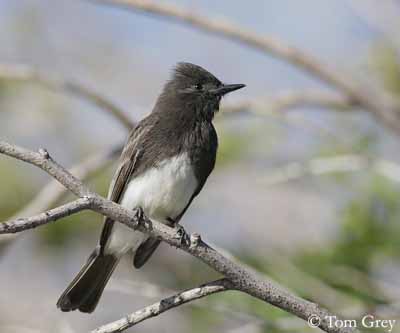
Black Phoebe
Sayornis nigricans
Passeriforme Order – Tyrannidae Family
BIOMETRICS :
Length : 15-18 cm
Wingspan : 27-28 cm
Weight : 15-22 g
LONGEVITY : Up to 3 years
DESCRIPTION:
Black Phoebe is a small black and white flycatcher.
Adult has black upperparts, head and breast. Belly and vent are white. Wings show paler feathers’ edges. Head, breast and upper back are rather sooty black. Lower back, wings and tail are brownish slate. White colour on belly form an inverted V. Dark tail shows white outer edges of external coverts.
Thin, pointed bill is black. Eyes are dark brown. Legs and feet are black.
Male and female show the same plumage, but during breeding season, male has cloacal protuberance and female has brood patch.
Fr: Moucherolle noir
All : Schwarzkopf-Phoebetyrann
Esp : Mosquero Negro
Ital : Febo nero
Nd : Zwarte Phoebe
Sd : Svart fibi
Photographs by Tom Grey
His website :
Tom Grey's Bird Pictures
Photographs by Tom Merigan
His website :
Tom Meriganís Photo Galleries
Text by Nicole Bouglouan
Sources:
A GUIDE TO THE BIRDS OF MEXICO AND NORTHERN CENTRAL AMERICA by Steve N. G. Howell, Sophie Webb - Oxford University Press - ISBN: 0198540124
BIRDS OF THE GREAT BASIN – by Fred A. Ryser - Univ of Nevada Pr -ISBN: 0874170796
FIELD GUIDE TO THE BIRDS OF NORTH AMERICA by National Geographic Society - National Geographic Society - ISBN: 0792274512
All About Birds (Cornell Lab of Ornithology)
What Bird-The ultimate Bird Guide (Mitchell Waite)
Wikipedia (Wikipedia, The Free Encyclopedia)

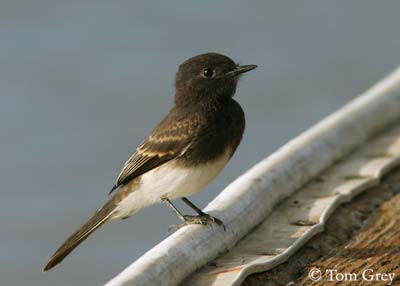
Juvenile is browner than adults, with pale cinnamon edging and fringing on upperparts. We can see buffy-cinnamon wing bars.
VOICE: SOUNDS BY XENO-CANTO
Black Phoebe’s most common call is a “tsip” used all year round during flights, when foraging, or against nest predators. It is a sharp sound, more plaintive than Eastern Phoebe’s call. We can also hear a loud “tseee”.
Song is a four syllable sound, a rising “pee-wee” followed by other descending “pee-wee”. Also a bright “pidl-eee” or “pi-ts-lee” repeated several times.
Chatter vocalizations are used when male approaches female and during sexual behaviour.
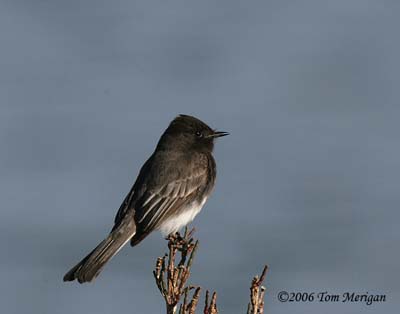
HABITAT:
Black Phoebe favourite habitats are coastal cliffs, river banks, shorelines of lakes and ponds, creeks and streams, fountains in parks. It can be found from sea level to 3,000 metres of elevation. This species is associated with water, accompanied by source of mud required for nest construction.
RANGE:
Black Phoebe breeds along Pacific Coasts, from southern Oregon to Central America into South America.
It winters in most of breeding range, but northern populations may winter along Gulf of California.
BEHAVIOUR:
Black Phoebe sits and waits on exposed perches, waiting for preys. It takes prey in open areas and from air. It forages over grasslands, water, roads, gardens and parks. During breeding season, mates forage separately, male in open areas, and female inside and at canopy edge.
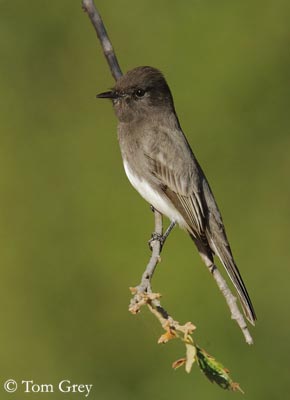
Black Phoebe usually initiates flight from low perch after located prey, and it will pursue it until capture, in short and direct flight. It sallies from perch and hawks prey from the air, or gleans it from the ground or the water surface of a pond. It may skim floating insects on water.
Black Phoebe rarely moves on ground, preferring to fly. It may occasionally land on ground near prey, and hop for capturing it.
When breeding season starts, frequent territorial disputes occur, including chasings and vocalizations. Wing-flicking, wing-drooping, crest-raising, tail-pumping and fanning, and chasing are used during these disputes.
Birds may also flutter from perch to perch with erect crest, tail pumping and fanning. Territory holder and intruder may hover face to face with tail fanned and upright bodies. These flights usually occur at territory boundaries.
For territorial maintenance, birds avoid each other, but during establishment of territories, direct confrontations occur with flight displays and regular chases.
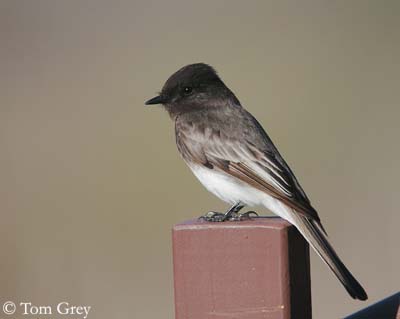
Black Phoebes are monogamous, and pair bonds last through breeding season. Male frequently approaches perched female with fluttering flight, and female leaves the perch. Female may assume submissive posture with low retracted head and fluffed feathers. Male tries to hover in front of and behind her. If she is intolerant at first, she accepts after several days or weeks, and male can land briefly on her back for copulation.
Male may perform some flight displays during this period. It flies with fanned tail and fluttering wings. It also performs short zigzags or spirals. We can hear songs during these displays.
Sometimes, courtship displays are engaged at nest-site, with hovering, holding body upright and fanning tail in front of old nest. Female follows it. Both sexes initiate chasing at this period.
Black Phoebe responds with alarm calls and flights to birds of prey and corvidae which threaten nests. It may swoop down at terrestrial predators and snap bill.
FLIGHT:
Black Phoebe has direct flight with steady wing beats. It may hover while gleaning prey from various places, or within clouds of flying insects. It can perform some acrobatic flights with zigzags and spirals during flight displays.
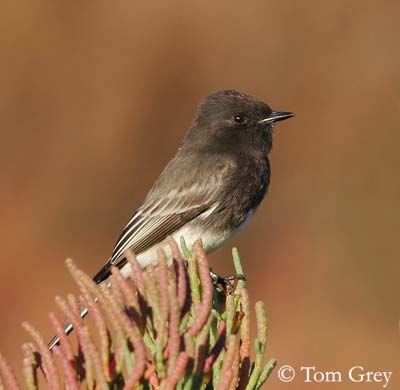
REPRODUCTION:
Black Phoebe female selects nest-site. Nest is situated above water, and above high-water mark. Nests situated above the ground are higher than others. Nest may be found in dirt ledges along streams, sheltered places on large rocks over water, or in tree under broken branch, walls…
Female throws mud pellets onto vertical surface, in order to form a line, horizontal or upwards arc. Then, she builds an open cup cemented with mud to a wall or other support. Mud is mixed with grass, dry vegetation or hair. Interior is lined with woven plant fibres, feathers and hair. It is usually situated under a ceiling, in a sheltered place, such crevices, ledges…
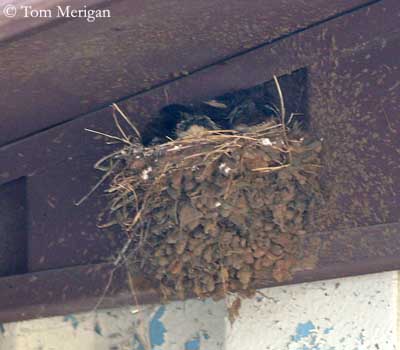
Female lays 1 to 6 white eggs slightly spotted around large end. Incubation lasts about 15 to 17 days, by female. Male defends the area around the nest, and may share brooded duties with female. Both adults feed the chicks, carrying insects to the nest. Young fledge at about 14 to 21 days after hatching.
This species produces two broods per season.
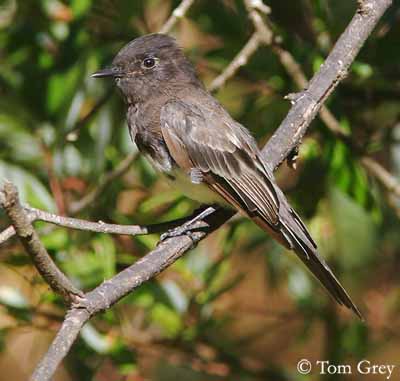
DIET:
Black Phoebe is mainly insectivorous. Some birds are well adapted to capturing small fish. It may sometimes eat small berries.
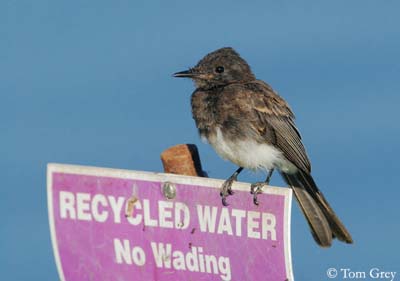
PROTECTION/ THREATS / STATUS:
Black Phoebes are threatened by continued destruction of riparian habitat and water use practices. That reduces suitable habitats for breeding and feeding. However, construction of bridges and buildings near water provides additional nest-sites fro this species, as human-made lakes and canals.